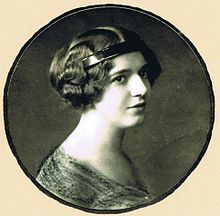Ora Doelk
Ora Doelk , née Margarete Toni Martha Zeuschner (born November 2, 1893 in Breslau , † September 21, 1984 in Hamburg ) was a German expressive dancer and choreographer .
Life
Ora Doelk spent her childhood and youth in Breslau as the daughter of the businessman Richard Zeuschner and his wife Anna, née Nowatzki, who came from Poland. This is where her Polish roots, so often quoted later, lay. After her father's death in 1908, she moved with her mother to Hamburg , where the two older sisters worked as milliners . Ora started rather reluctantly - her lifelong dream was already to become a dancer - an apprenticeship, also as a milliner. She later worked in this profession for a few years, which took her to Zurich in 1915 , where she took her first artistic courses and was the beginning of her path to becoming a celebrated expression dancer.
During an extensive tour of Germany touring in 1920, she met her future husband, Jaques de Peñas, an internationally active merchant from Constantinople , in Dresden . Their son Gerd Joachim was born in Vienna in 1921 († February 5, 1945). After years together in Italy, she surprisingly decided in 1922 to continue her artistic career in South America until she returned to Europe by mid-1925 and ended her artistic career a year later. In 1927 she opened an elegant hotel and guest house in Hamburg-Harvestehude ; from then on she was a businesswoman and devoted herself to the upbringing of her son and later, after his untimely death, her granddaughter.
She died on September 21, 1984 at the age of 90 in Hamburg.
Artistic importance
In 1915, Ora Doelk took courses in rhythmic gymnastics at the Semmler-Rincke dance school in Zurich , where small performances were also organized. Here she discovered her talent and moved to Geneva in 1916, where she was accepted at the institute of Émile Jaques-Dalcroze . He was very surprised when he heard that she had only started taking courses in rhythmic gymnastics a year earlier and had not had any dance training until then.
Ora Doelk began choreographing expressive or “interpretive” dances . Her first tour took her through Switzerland in 1918, followed by a tour of Germany's important cities in 1919/20. A year later she moved with the family to Milan ; she danced with great success several performances in Rameau's opera Platée and in the years 1920/21 there were other highly regarded performances in northern Italian cities.
Then Ora Doelk decided to continue her artistic path in South America and in 1922 set out with her son on the crossing to Argentina . Here she found an impresario who organized many appearances and guest performances on the continent for her: at the beginning of these remarkable years, a guest performance took place in Buenos Aires at the Teatro Colón ; Tours in Chile , Peru and Cuba (own choreographies , costumes, stage design) followed. In 1926 some appearances in Germany followed. Then she ended her artistic career.
Important solo works
- Porcelain (costume by Paul Erkens) - A. Dvořák Allegro vivo from Poèmes Symphoniques op.107
- Gothic Art - A. Dvořák Largo from The New World
- Wooden doll - F. Chopin Mazurka
- Faun from the opera Platée by JP Rameau
- Cubist Grotesque - F. Schubert Scherzo
- Reverie - P. Tschaikovsky Sognando
- C. Saint-Saëns : Danse macabre
- F. Chopin : Au Printemps
Press
- Ora Doelk knows how to read musical language and how to make it literally vivid, so that it gains unimagined expressiveness. (Basler Nachrichten, 1918)
- Her dances are completely out of the ordinary. They are captivating and always new. (Berliner Tageblatt, 1919)
- Ora Doelk is dance, is living music. ( Leipzig Latest News , 1920)
- So it was granted to other circles to get to know the wonderful art of this dancer. It brought - in accordance with the framework - nothing but cheerful things and once again garnered great, enthusiastic ovations. (Milan, Corriere de la Sera, December 1920)
- Of all the dancers who have performed on Chilean stages, Ora Doelk is the most musical. (Santiago de Chile, German newspaper, December 1923)
| personal data | |
|---|---|
| SURNAME | Doelk, Ora |
| ALTERNATIVE NAMES | Zeuschner, Margarete Toni Martha (maiden name) |
| BRIEF DESCRIPTION | German expressive dancer and choreographer |
| DATE OF BIRTH | November 2, 1893 |
| PLACE OF BIRTH | Wroclaw |
| DATE OF DEATH | September 21, 1984 |
| Place of death | Hamburg |


